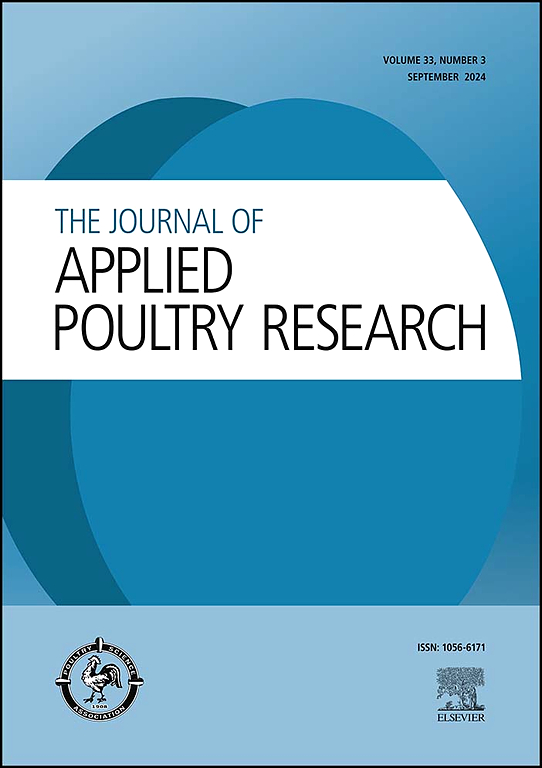Development and testing of an indoor air scrubber for removing ammonia from air within poultry houses
IF 2
3区 农林科学
Q2 AGRICULTURE, DAIRY & ANIMAL SCIENCE
引用次数: 0
Abstract
High levels of ammonia (NH3) in poultry houses negatively affect bird BW, FCR, and disease resistance, and negatively affect the health of agricultural workers. The objectives of this research were to build and test the efficacy of a newly developed indoor air scrubber on reducing NH3 concentrations. A full-scale prototype was constructed, and a series of experiments were conducted in a shop under various conditions using sulfuric acid for capturing NH3. Dilute sulfuric acid (1%) was sprayed through 21 nozzles placed in six rows at multiple heights and orientations. Scrubbing efficiency was tested for two h at five NH3 concentrations (10, 25, 50, 75 and 100 ppm) and two air flow rates (7,372 and 9,334 m3 h-1) with three replications of each of the ten scenarios. The efficiency of the scrubber decreased with increases in air flow rate and NH3 concentration. At the lower air flow rate the percent NH3 reduction was 99, 98, 96, 94, and 93% when inflow concentrations were 10, 25, 50, 75, and 100 ppm NH3, respectively, with corresponding outflow concentrations of 0.1, 0.7, 2.2, 4.2, and 7.3 ppm NH3. At the higher flow rate, the percent reduction was 90, 91, 88, 87 and 87% at 10, 25, 50, 75 and 100 ppm NH3, respectively, with corresponding outflow concentrations of 1.1, 2.4, 6.1, 9.9, and 13.1 ppm. When inflow NH3 levels were relatively high (>50 ppm), the scrubber captured over 100 g N hr-1. This technology would result in much lower NH3 concentrations in poultry houses, which would improve poultry production and worker health, and capture valuable nitrogen fertilizer, while reducing air and water pollution
用于去除禽舍空气中氨的室内空气洗涤器的开发和测试
禽舍内氨(NH3)水平过高会对禽鸟体重、食积比和抗病能力产生负面影响,并对农业工人的健康产生负面影响。本研究的目的是建立和测试新开发的室内空气洗涤器对降低NH3浓度的功效。构建了全尺寸原型机,并在车间中进行了一系列实验,在各种条件下使用硫酸捕获NH3。稀硫酸(1%)通过6排不同高度和方向的21个喷嘴喷射。在5种NH3浓度(10、25、50、75和100 ppm)和2种空气流速(7,372和9,334 m3 h-1)下测试了2小时的洗涤效率,每种情况重复3次。随着空气流量和NH3浓度的增加,洗涤器的效率降低。在较低的空气流速下,当NH3流入浓度分别为10、25、50、75和100 ppm,流出浓度分别为0.1、0.7、2.2、4.2和7.3 ppm时,NH3减少率分别为99、98、96、94和93%。当NH3浓度分别为1.1、2.4、6.1、9.9和13.1 ppm时,当NH3浓度为10、25、50、75和100 ppm时,NH3的去除率分别为90%、91%、88%、87%和87%。当流入NH3水平相对较高(50 ppm)时,洗涤器捕获超过100 g N / hr-1。这项技术将大大降低禽舍中的NH3浓度,这将改善家禽生产和工人健康,并捕获宝贵的氮肥,同时减少空气和水污染
本文章由计算机程序翻译,如有差异,请以英文原文为准。
求助全文
约1分钟内获得全文
求助全文
来源期刊

Journal of Applied Poultry Research
农林科学-奶制品与动物科学
CiteScore
4.10
自引率
10.50%
发文量
80
审稿时长
104 days
期刊介绍:
The Journal of Applied Poultry Research (JAPR) publishes original research reports, field reports, and reviews on breeding, hatching, health and disease, layer management, meat bird processing and products, meat bird management, microbiology, food safety, nutrition, environment, sanitation, welfare, and economics. As of January 2020, JAPR will become an Open Access journal with no subscription charges, meaning authors who publish here can make their research immediately, permanently, and freely accessible worldwide while retaining copyright to their work. Papers submitted for publication after October 1, 2019 will be published as Open Access papers.
The readers of JAPR are in education, extension, industry, and government, including research, teaching, administration, veterinary medicine, management, production, quality assurance, product development, and technical services. Nutritionists, breeder flock supervisors, production managers, microbiologists, laboratory personnel, food safety and sanitation managers, poultry processing managers, feed manufacturers, and egg producers use JAPR to keep up with current applied poultry research.
 求助内容:
求助内容: 应助结果提醒方式:
应助结果提醒方式:


